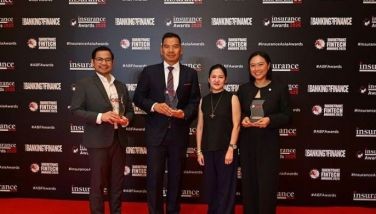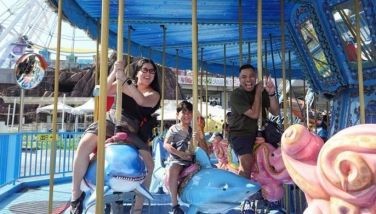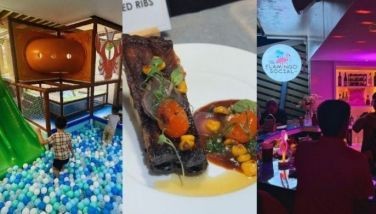Why is art a good investment?
The true work of art is but a shadow of the divine perfection. — Michelangelo
It took me 40 years to find out that painting is not sculpture. — Paul Cezanne
Cezanne, you see, is a sort of God of painting. — Henri Matisse
Why are some of the smartest and most financially astute tycoons in the Philippines — like Metrobank taipan George SK Ty, self-made realty billionaire Manny Villar, and SGV Group founder Washington SyCip — top art collectors? In the West, some of the best business leaders, from Iraqi Jewish advertising billionaire Charles Saatchi (now a British citizen) to American-Jewish cosmetics tycoon Ronald Lauder, Microsoft founder Bill Gates (his art collection is owned by his firm) to the late oil tycoon J. Paul Getty collected art. In China, emperors, scholars and taipans have for thousands of years collected art, from paintings and sculptures to calligraphy.
First of all, I wish to state my opinion that art is first and foremost about beauty and culture, therefore essentially intangible in value and should be viewed as more than an investment. Yes, art can be a good investment, according to Philippine STAR reader, avid art collector and TV host Julius Babao, who suggested I write about this topic. However, like Babao, I urge everyone to appreciate art primarily as works of beauty and expressions of culture, with the commercial aspect as a far secondary consideration, or else it wouldn’t be enriching for the soul, fun and exciting.
Why is art a good investment? Here are a few of my ideas, from the perspective of a total non-expert who has loved art since he was still a kid:
• For a writer like me, since writing is itself an art, I believe art is priceless or beyond price tags. My opinion is that the price a person is willing to pay for a piece of art he or she loves or is enamored of is a good and correct price, whatever the galleries or critics might say.
In 2006, cosmetics tycoon Ron Lauder was willing to pay US$135 million (at that time equivalent to buying a fully equipped Boeing 787 Dreamliner jet good for 300 passengers!) for a Gustav Klimt 1907 painting entitled “Portrait of Adele Bloch-Bauer I” to display in his Neue Galerie in New York City. My personal opinion is that was a correct price. I believe there is no “wrong price” in buying art that one truly loves.
• Like diamonds, gold, branded luxury items or even real estate, art is much sought-after for its intrinsic beauty. It can last centuries, and can be passed on to great-grandkids and future generations as an inheritance, which I believe is more valuable than just cash or land. Sadly, in some Asian or Western societies, some heirs of wealthy, art-collecting tycoons do not appreciate the diligence and passion of their forebears in collecting art through the decades and just auction them off in exchange for cold cash.
• Also like diamonds or branded luxury items, the limited supply created by top-caliber artists and the rising demand for certain branded artists’ works make some of the finest artworks quite high in price, more valuable than even jewelry or other luxury goods.
• Art is part and parcel of culture, the history of a society and the world, and therefore valuable.
• Another theory of mine as to why the prices of Philippine art have risen so high in recent years is that it’s part of the spillover effect of China’s phenomenal “economic miracle,” with many of their rich buying Chinese art and antiques, and thus pushing the prices of Asian art to the stratosphere in Sotheby’s and Christie’s auctions. Compared to Chinese art, some in the multi-million-dollar range, Philippine and Southeast Asian artworks are good bargains.
As a person who started a modest art collection in August 2009 focusing on young, contemporary painters mostly in their 20s to 40s, my foremost consideration is whether I like the painting or not and if it moves or intrigues me; the reputation or fame of the artist is not the main consideration. I’m not a tycoon, but I buy art for keeping and to inspire me. It’s also my fantasy to someday open a free public art museum with all works personally chosen by me.
Among the works I’ve bought include those by Mark Justiniani, Elmer Borlongan (one of his four works that I own I bought at the Oct. 3, 2009 Ateneo Art Auction organized by our former dean Dr. Leo Garcia to raise funds for scholarships in time for the Ateneo’s 150th anniversary), Rodel Tapaya, Jon Jaylo (I bought his oil painting at the Nov. 16, 2009 “Art for Youth Sake” charity project by idealistic Councilor Winnie Castelo and wife, Precious, to build a daycare center in Payatas, Quezon City), CJ Tañedo, Lynyrd Paras, Wire Tuazon (I bought his oil painting from the Nov. 12-14, 2009 “Art Flood” charity project of Slab/Silverlens with the Red Cross to help Ondoy victims), Kiko Escora and others. I’ve also bought works by my favorite multi-awarded sculptor, Juan Sajid Imao. I also own other works that were given me as gifts before, such as those by top art teacher Fernando Sena, Allan Cosio and others.
I’ve bought works from very talented young artists who have never held a solo exhibit yet and are not famous, like 2009 Metrobank painting competition semi-finalists Anthony F. Mallari, Jeffrey S. Almario and Edwin P. Martinez. I just admire their work.
Thanks also to Philippine STAR reader and food exporter Henson Tiu Laurel for also suggesting that I write a column about art as an investment. He is a former University of the Philippines philosophy professor, as well as founder of the Diliman Book Club, of which this writer is the youngest member. Other members are mostly UP professors from different fields, including a doctor and hospital owner, a rural bank owner, a fast-food chain owner, a beauty chain tycoon, an activist and two martial law-era detainees for subversion … we all love books.
Laurel asked me to review and discuss a book he recently gifted me with, entitled The $12 Million Stuffed Shark: The Curious Economics of Contemporary Art and Auction Houses by London School of Economics and Harvard Business School Professor Don Thompson. His irreverent work is a well-researched, interesting, sometimes funny and a fun book to read by all people who are interested in art, business or economics. It analyzes the contemporary art market as a result of the interesting dynamics among artists, top auction houses, dealers, big collectors, museums, etc., and the sometimes incestuous links between and/or even rivalries among them.
During the last session of our Diliman Book Club when I reviewed this book, our special guests included topnotch young painter and UP graduate Geraldine Javier (a top favorite in international auction houses Sotheby’s and Christie’s, as well as Julius Babao’s most recent “Art 2 Heart” charity auction last Dec. 19, with Javier’s 64x39-inch oil painting rising in price from P200,000 to P1.15 million due to many bids).
Another guest who attended was Tin Aw Art Gallery co-owner Dawn Atienza, who is also cousin of award-winning painter Mark Justiniani and who also represents his girlfriend, top painter Joy Mallari. Justiniani has a solo exhibit at Slab in February, while Mallari has her own exhibit at Ayala Museum, also in February.
Yes, I agree. Art is a good investment and I urge more people with excess funds to support artists by buying art that you really like and not only what is fashionable or famous. Hopefully, we can also support other artists in literature, like novels and poetry! However, as I’ve stated before, investment shouldn’t be the main consideration for buying art — for it would be unexciting and meaningless — but buy art due to a genuine appreciation for beauty and culture, which ultimately uplift us all.
* * *
Thanks for your many letters; all will be answered (willsoonflourish@gmail.com).




















